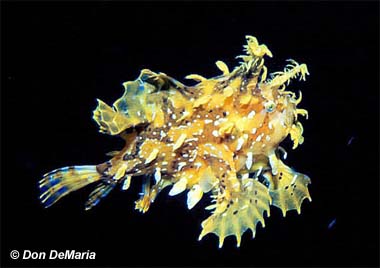
Histrio histrio
This odd fish is named after the sargassum sea grass beds it camouflages itself in. The color can change rapidly to match its surroundings. It is a voracious hunter and will eat other sargassumfish. Sitting very still, the sargassumfish ‘fishes’ with its rod-like illium topped with a lure-like lump. It crawls around the sargassum with its specialize fins, and when threatened, can hop out of the water onto the sea weed mats for extended periods of time.
Order – Lophiiformes
Family – Antennariidae
Genus – Histrio
Species – histrio
Common Names
The common name “sargassum fish” refers to its preferred habitat – sargassum algae beds floating in the ocean. Other common names found for this species are sargassumvis (Afrikaans); sargasso-tudsefisk (Danish); frogfish, sargassum anglerfish, sargassumfish (English); houéolonon (Fon GBE); baudroie (French); novu lovo (Gela); sargassofisch (German); hanaokoze (Japanese); gali-kendi, gouthere-mas (Mahl); sargassoulke (Norwegian); antenarius sargasowy (Polish); frogfish, peixe-doutor, peixe-pescador (Portuguese); sargassovyi morskoi kloun (Russian); pez sargazo (Spanish); marmorerad sargassoulk, and tångulk (Sweden).
Importance to Humans
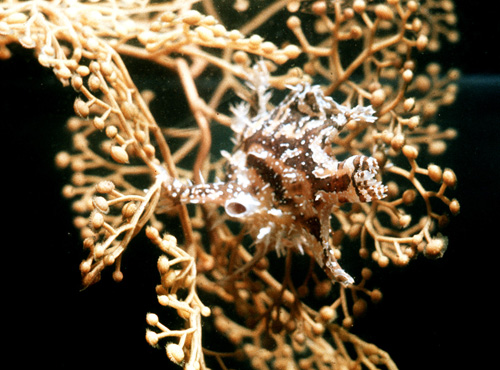
Sargassum fish are not known to be routinely harvested for food, but are sold in pet stores. They can survive in salt water reef ecosystem aquariums with the water at a temperature of 75° to 80° F (23.8° to 26.7° C) and a pH level of 8.1 to 8.4.
Danger to Humans
There have been reports of ciguatera poisoning from dealing with these fish. Humans mainly get it from eating fish that contain the toxin ciguatoxin which found on the flesh of the fish. This toxin is present in the micro-algae Gambierdiscus toxicus.
Conservation
The sargassum fish is not listed on the World Conservation Union (IUCN) Redlist as an endangered or threatened species. The IUCN is a global union of states, governmental agencies, and non-governmental organizations in a partnership that assesses the conservation status of species.
> Check the status of the sargassum at the IUCN website.
Geographical Distribution
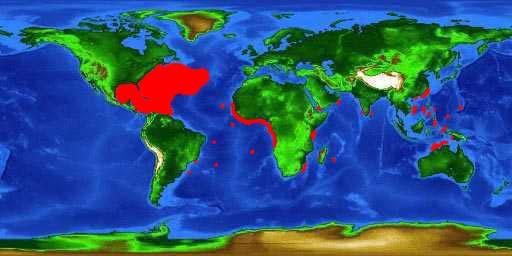
The sargassum fish is found throughout the tropical and subtropical seas of the world. In the Indian Ocean, they range from the tip of South Africa north to Indian and Sri Lanka (eastwardly). This range also includes the Red Sea, Madagascar, Réunion and Mauritius. This fish occupies the area of Hokkaio to tropical Australia in the western Pacific Ocean, including Taiwan, Philippines, Moluccas, southern Papua, New Guinea, Guam, Tonga, New Caledonia, and New Zealand. The sargassum fish is also seen in the Mariana Islands in Micronesia. In Australia this fish is found as far south as Perth in the west and Sydney in the east. For some unknown reason the eastern Pacific is having problem supporting the fish. The sargassum fish is found in the western Atlantic by in the Gulf of Maine to the mouth of the Rio de la Plata, Uruguay. In the eastern Atlantic Ocean, this fish is found in Azores and off the coast of West Africa.
Habitat
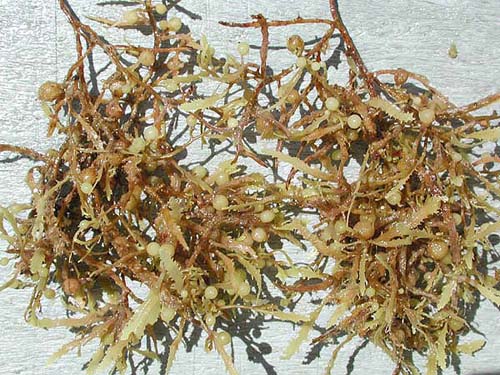
Sargassum fish are found in marine habitats with a depth of 35.3 feet (11 m). The sargassum fish spends it entire life associated with floating sea grass beds – mostly sargassum algae. They can be found in shore and bay waters during times of storms when they get blown inland. Sargassum fish do not do much swimming, rather they just follow the sargassum beds.
Biology
Distinctive Features
The sargassum fish has fleshy weed like appendages that blend in with the algae sargassum. Their skin is smooth, lacking dermal spines which distinguish it from other fish in the family. The head and body appear as one unit with no defined separation because the gill openings appear as pores on the lower margin of the pectoral fin (near the base of the fin). The sargassum fish has an upturned mouth with an illium over the margin of the eyes. The illium is a slender tentacle with the tip bearing a bulbous swelling. This fish has a laterally flattened appearance.
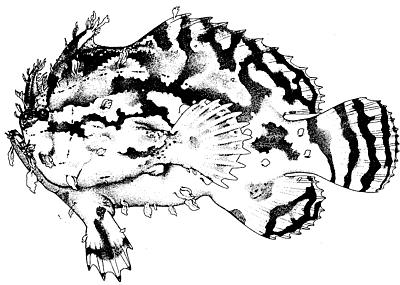
Coloration
The color of the sargassum fish is pale cream to greenish to dark brown. They closely resemble the sargassum alga which allows them to blend in with the plant.
Size, Age, and Growth
The maximum size for sargassum fish is 7.87 inches (20 cm). The fish is considered a larva at 0.08 inches (2.0 mm) total length with the head round and large and the fins fully formed. Also a pigmented double notched eye is present. At this stage, the larva is in a spherical, integumentary envelope which is hooked onto the body in three places, mouth, anus and the base of all the fins. The fins stick out from the envelope at this point. When the larva reaches 0.35 inches (9.0 mm) the envelope completely fuses with the epidermis and the fish is considered a juvenile.
Food Habits
The sargassum fish feeds on shrimp and other fishes that come to the sargassum bed for refuge. They are good predators because their coloration blends in with the sargassum algae, allowing them to ambush their prey. They can also use their illium as a lure for their prey.
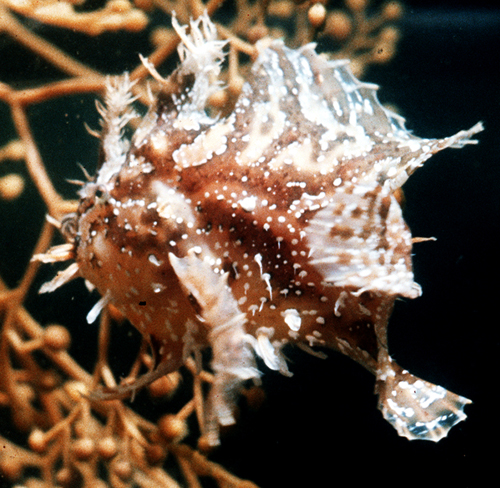
Reproduction
The sargassum fish are dioecism meaning that individuals are either male or female but not both; they are sexually distinctive. During courtship the male follows the female around very closely until they both rush to the surface, where spawning occurs. Eggs are produced in a gelatinous floating mass that the male inseminates through external fertilization. The eggs will remain in the mass until they are ready to hatch. This mode of reproduction is termed oviparous, where the eggs hatch outside the female body.
Predators
The main predators to the sargassum fish are sea birds and larger fishes. They can escape underwater predators by jumping out of the water onto the floating seaweeds. They can survive out of water for extended periods of time.
Taxonomy
The sargassum fish was first named Lophius histrio by Linnaeus in 1758. The scientific name of this fish later went through five name changes as follows: Pterophrynoides histrio, Pterophryne histrio, Antennarius histrio, Histrio histrio, and Chironectes histrio. The currently valid scientific name is Histro histrio. The current genus is derived from the latin word “histrionicus” which means related with actors – so named because of the movement this fish makes before catching its prey.
Other synonyms referring to this fish include Lophius laevis Lacepède 1804; Pterophryne ranina, Antennarius raninus, Cheironectes raninus, Lophius raninus, and Histrio raninus Tilesius 1809; Lophius cocinsinensis Shaw 1812; Chironectes variegates, and Pterophryne variegates Rafinesque 1814; Lophius gibba, Pterophryne gibba, Lophius gibbus, Historio gibbus, Pterophrynoides gibbus, Antennarius gibbus, Chironectes gibbus, Peterophryne gibbo Mitchill 1815; Pterophryne laevigata, Chironectes laevigatus, Antennarius laevigatus, Lophius laevigatus, Pterophryne laevigatus, Cheironectes laevigatus Cuvier 1817; Lophius calico Mitchill 1818; Lophius geographicus Quoy & Gaimard 1825; Antennarius nitidus Bennett 1827; Antenarius mesogallicus, Antennarius nesogallicus, Chironectes nesogallicus, Pterophryne picta, Histrio pictus Valenciennes 1837; Cheironectes pictus vittatus Richardson 1844; Chironectes arcticus Düben & Koren 1846; Chironectes barbatulatus, Antennarius barbatulus, Chironectes barbatulus Eydoux & Souleyet 1850; Antennarius lioderma Bleeker 1865; Chironectes sontagii Müller 1865; Antennarius inops Poey 1881; Histrio jagua Nichols 1920; and Lophius pelagicus Banks 1962.
Prepared by: Stephanie Boyer